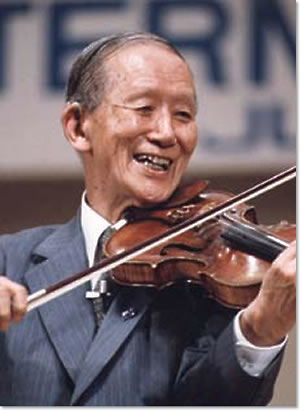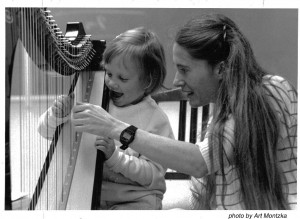 The story goes that Shinichi Suzuki was playing in a string quartet one day over 60 years ago, when he suddenly stopped in mid-bow and cried “All Japanese children speak Japanese!” To his fellow musicians this probably seemed a fairly obvious statement, not worthy of breaking up a rehearsal. However, what Suzuki had realized was that all Japanese children speak Japanese, not just the “gifted” or “intelligent” ones. All. Since language is learned, not inherited, there exists here a teaching method with Universal Success. And this truly is a revelation!
The story goes that Shinichi Suzuki was playing in a string quartet one day over 60 years ago, when he suddenly stopped in mid-bow and cried “All Japanese children speak Japanese!” To his fellow musicians this probably seemed a fairly obvious statement, not worthy of breaking up a rehearsal. However, what Suzuki had realized was that all Japanese children speak Japanese, not just the “gifted” or “intelligent” ones. All. Since language is learned, not inherited, there exists here a teaching method with Universal Success. And this truly is a revelation!
The rest of Suzuki’s life was devoted to understanding this teaching method (which he called the “Mother-Tongue” method), and applying it to other areas of learning. He started with music, which is auditory just like learning a language, and then went on to apply the method to Math, Physical Education, Haiku, and other subjects.
The most important element in learning a language is hearing it, having it be part of the child’s environment. Then certain words are repeated over and over until the child starts to imitate them. These words are never dropped from the vocabulary, but are retained and added to, giving the child a repertoire of words to draw from.
Teaching music by the Suzuki Method works the same way, making music a part of the child’s environment by using recordings of the Suzuki repertoire played over and over. Once learned, the pieces remain in the student’s working musical vocabulary. And just as you would not teach a child to read before learning to speak, we teach the children to play first, then teach the reading after the technical and musical basics have been established.
 Just as every child can learn to speak his/her own language fluently, Suzuki teachers approach their students with the same certainty that every child will be able to fluently learn the language of music. This notion that “Talent” is taught, not inborn, is a new one to many musicians, but amply born out by the great success of Suzuki students the world over. This is not to say that all students will learn at the same rate. Each student will have his/her own pace of learning, but all are able to achieve a high degree of technical skill and musicality.
Just as every child can learn to speak his/her own language fluently, Suzuki teachers approach their students with the same certainty that every child will be able to fluently learn the language of music. This notion that “Talent” is taught, not inborn, is a new one to many musicians, but amply born out by the great success of Suzuki students the world over. This is not to say that all students will learn at the same rate. Each student will have his/her own pace of learning, but all are able to achieve a high degree of technical skill and musicality.
One of the most exciting aspects of the Suzuki approach is the teacher training. Teachers get together every year at summer workshops to learn about the method, how it applies to their instrument, and how to go about teaching it. There is a series of Units set up by the Suzuki Association of the Americas (SAA) to ensure that every teacher has thorough training in the method. (Please see the “Teacher Training” section in this website for specific information on receiving Suzuki training.)
This sharing of ideas forms the basis for the whole spirit of the Suzuki movement. The aim is to educate the children in a supportive, non-competitive environment, to develop the whole child, and to teach skills that are applicable to all areas of a person’s life.
Suzuki always believed that his goal was not to make great musicians, but, through the study of music, to help all children become wonderful human beings who will make the world a better place. Many of you may smile, thinking, “How quaintly idealistic.” But watching these children as they follow their many different paths in life, seeing the kind of people they’ve become and their effect on others, one can only feel that maybe Pablo Casals was right when he heard a concert of Suzuki students and said, “Perhaps it is music that will save the world.”